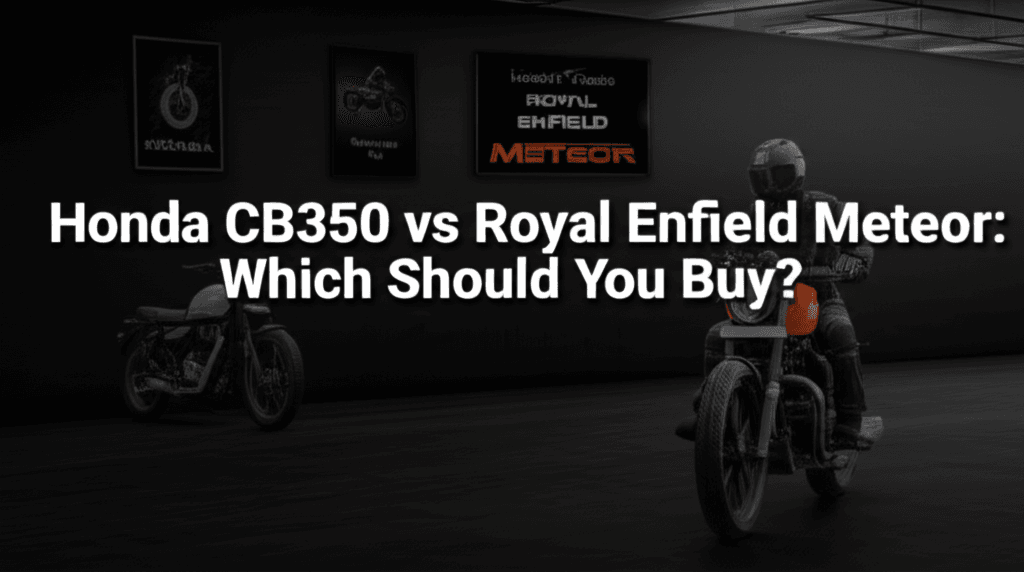Thinking about a modern classic motorcycle that blends everyday usability with timeless style? Two of the most popular choices in the 350 cc retro-cruiser class are the Honda CB350 and the Royal Enfield Meteor 350. Both promise accessible performance, approachable ergonomics, and that charming thump you want from a mid-capacity single. Yet, they deliver very different personalities on the road. If you are torn between these two, this comprehensive comparison will help you decide which one fits your riding style, budget, and long-term expectations.
In this guide, we break down performance, comfort, features, ownership costs, reliability, and riding feel. You will also find practical tips, real-world scenarios, and a detailed FAQ. By the end, you will know whether the refined and tech-savvy Honda CB350 or the laid-back and characterful Royal Enfield Meteor 350 is the better buy for you.
At a Glance: Key Differences That Matter
Positioning and Personality
The Honda CB350 (sold in variants like H’ness CB350 and CB350RS in many markets) channels classic UJM styling with an upright stance and a subtle, refined exhaust note. The Royal Enfield Meteor 350 leans into cruiser DNA with a low seat, forward-set pegs, and a more relaxed riding posture. Your choice largely hinges on whether you prefer a roadster with responsive handling (CB350) or a cruiser built for comfort and easygoing miles (Meteor).
Quick Spec Snapshot
- Engines: Both are 349–350 cc, air-cooled, single-cylinder, fuel-injected.
- Power and Torque: CB350 makes slightly more power and crisper midrange; Meteor emphasizes low-end torque and linear delivery.
- Weight and Feel: CB350 typically feels lighter and more agile; Meteor feels planted and stable.
- Electronics: Both offer dual-channel ABS; CB350 often adds traction control and voice-enabled connectivity in top trims; Meteor offers Tripper navigation on select variants.
- Ergonomics: CB350’s neutral stance suits city sprints and twisty routes; Meteor’s cruiser ergonomics suit highway droning and relaxed commutes.
Best For
- Honda CB350: Riders wanting refinement, agile handling, and modern features without sacrificing classic looks.
- Royal Enfield Meteor 350: Riders prioritizing comfort, style, and a relaxed cruiser vibe with strong brand heritage.
Design, Ergonomics, and Build Quality
Styling and Presence
Honda CB350: The CB350 wears its heritage proudly—round LED headlamp, teardrop tank, generous chrome on certain trims, and clean lines. The CB350RS variant introduces sportier accents, blacked-out components, and a slightly more aggressive tail section. The detailing on switchgear and paint finish feels premium and tightly screwed together, reflecting Honda’s reputation for fit and finish.
Royal Enfield Meteor 350: The Meteor embraces the cruiser template. You get a low, scooped seat, a raked-out stance, and a broad handlebar that invites relaxed arms-out riding. Colorways and pinstriping are tasteful, and chrome accents are used judiciously. Royal Enfield’s design language leans into emotional appeal—this is a bike you buy as much with your heart as with your head.
Ergonomics and Comfort
- Seat height: Meteor’s seat is typically lower, making it friendly for shorter riders and inspiring confidence at low speeds. The CB350’s seat is higher but still approachable for most.
- Rider triangle: CB350 offers a neutral, upright posture with mid-set pegs—great for maneuverability and city riding. Meteor’s forward-set pegs and swept-back bars deliver all-day comfort on straight roads.
- Pillion comfort: Both are pillion-friendly, with the Meteor offering slightly more real estate and cruiser-grade cushioning; CB350’s flatter bench aids repositioning in traffic.
Build Quality and Finish
Perceived quality is strong on both, but Honda’s consistency in panel gaps, switchgear tactility, and paint durability often edges ahead. The Meteor, however, brings robust metalwork, a charming old-school feel, and improved quality over earlier generations of RE singles. Long-term owners report that both handle daily wear well when maintained on schedule.
Engine, Performance, and Handling
Engine Character and Refinement
Honda CB350: The CB350 is known for its smooth, vibe-controlled engine with a clean midrange surge. Throttle response is predictable and slightly sharper, making urban overtakes effortless. Honda’s tuning prioritizes refinement—less buzz at cruising speeds and a composed feel at 80–90 km/h.
Royal Enfield Meteor 350: The Meteor’s long-stroke single is all about a lazy, tractable pull from low revs. Acceleration is steady rather than urgent. The signature thump is gentler than older REs, but it still offers a satisfying beat. Vibes are well-contained up to typical cruising speeds; push past that and you may feel a mild tingle in pegs and bars, common for single-cylinder cruisers.
City, Highway, and Twisties
- City riding: CB350 feels lighter on its feet. The clutch is light, and gearshifts are slick. Meteor counters with stellar low-speed stability and a super-friendly seat height. Filtering is slightly easier on the CB350 due to its tighter turning feel.
- Highway cruising: Meteor’s relaxed ergos and planted chassis make it a comfortable 80–100 km/h cruiser. CB350 can cruise at similar speeds with less strain and a touch more headroom for overtakes. Wind protection is minimal on both unless you add an accessory screen.
- Curvy backroads: CB350’s neutral geometry and firmer setup offer better corner-to-corner agility. Meteor prefers sweeping bends to tight switchbacks, where its raked-out stance brings calm stability rather than quick flickability.
Braking and Ride Quality
Both bikes feature dual-channel ABS. The CB350’s brakes have a more immediate bite and progressive feel, suiting spirited riding. The Meteor’s braking is predictable, matching its relaxed pace. For suspension, the Meteor’s softer setup irons out potholes and rough surfaces at moderate speeds, while the CB350’s slightly firmer damping offers better control but transmits a bit more road texture to the rider.
Fuel Efficiency and Range
Real-world riders typically report 35–42 km/l depending on traffic, load, and riding style for both motorcycles. With similar tank capacities, expect a practical range in the 350–450 km window. The CB350’s efficiency may hold slightly better at steady speeds due to its refined fueling.
Features, Technology, and Practicality
Instrumentation and Connectivity
- Honda CB350: Variants offer semi-digital clusters with gear position, distance-to-empty, real-time mileage, and in higher trims, Honda Smartphone Voice Control for calls, music, and turn-by-turn prompts via a helmet intercom.
- Meteor 350: The optional Tripper Navigation module provides Google-powered turn-by-turn navigation on a secondary pod. The main cluster includes a gear indicator, clock, and fuel gauge, presented in a retro analogue-digital layout.
Safety and Rider Aids
Both bikes include dual-channel ABS as standard on most trims. The CB350 typically adds Honda Selectable Torque Control (a basic traction control system) on certain versions, a rarity in this class. While not a performance aid, it adds a safety net on wet or loose surfaces. Lighting is LED on higher trims for both, improving night-time visibility.
Practical Touches
- Side-stand engine cut-off: Common on newer trims for both, preventing accidental starts in gear.
- USB charging: Available as standard or accessory, handy for navigation and commuting.
- Luggage options: Both brands offer factory and aftermarket solutions—saddlebags, rear racks, and engine guards. The Meteor’s cruiser layout makes it easy to mount soft panniers without interfering with the pillion.
Daily Usability
For daily commutes, both are friendly. The CB350’s clutch feel and throttle response are particularly accommodating in stop-go traffic. The Meteor’s low-speed balance and seat height reduce fatigue in crowded city centers. Heat management is generally good on both, with only mild warmth felt around the ankles in dense traffic on hot days.
Ownership Costs, Reliability, and Resale
Service Intervals and Costs
Both brands provide competitive service schedules and accessible dealer networks in most markets across Asia and beyond. Honda has a reputation for shorter service visits and consistent parts availability. Royal Enfield service costs are reasonable, and the brand’s mechanics are highly familiar with the platform, which helps with quick diagnosis and fixes.
Reliability and Durability
Honda CB350: Known for bulletproof reliability, clean fueling, and minimal unscheduled maintenance. Electricals and switchgear generally age well. Paint and chrome hold up strongly with regular care.
Royal Enfield Meteor 350: The J-platform engine introduced with the Meteor has proven to be markedly more reliable and refined than older RE singles. While Honda still leads in clinical reliability, the Meteor delivers robust day-to-day dependability that satisfies most owners.
Resale Value
Both bikes retain value well thanks to high demand. Honda’s reputation can translate to slightly stronger resale, especially for well-maintained, low-mileage bikes. Meteor’s cult following and brand heritage also keep prices buoyant, especially for popular colorways and limited editions.
Insurance and Running Costs
Insurance premiums tend to be comparable, with minor differences depending on region, rider profile, and accessory fitment. Fuel and tire costs are similar. The Meteor’s softer compound rear tire may wear a bit quicker if frequently ridden with a pillion or luggage, while the CB350’s firmer setup can return marginally longer tire life.
Real-World Riding Scenarios and Buyer Profiles
Urban Commuter
Pick the CB350 if your commute is dense and dynamic. Its nimble steering, predictable throttle, and precise brakes make navigating traffic smoother. The slightly higher seat offers better visibility over car roofs, while its turning agility helps in tight U-turns and narrow alleys.
Weekend Cruiser
Pick the Meteor 350 if your weekends involve long, relaxed rides on highways or scenic backroads. Its low seat, laid-back ergonomics, and serene stability reduce fatigue. Add a small screen, a backrest, and soft panniers, and you have a budget-friendly mile muncher.
New Rider or Returning Rider
Both are excellent for building confidence. If you want a gentle learning curve with classic control feel and a touch of tech safety (like basic traction control on the CB), the CB350 edges it. If being flat-footed and stress-free low-speed control matter more, the Meteor 350 shines.
Occasional Touring
Both can tour with comfort mods. The Meteor’s ergonomics favor steady-state cruising, while the CB350 offers wider versatility—comfortable on highways but more fun when the road turns twisty. For sustained two-up touring, consider a touring seat upgrade and luggage racks on either bike.
Side-by-Side Comparison Table
| Aspect | Honda CB350 | Royal Enfield Meteor 350 |
|---|---|---|
| Design | Classic roadster, premium fit and finish | Laid-back cruiser, strong visual presence |
| Ergonomics | Neutral, upright, mid-set pegs | Low seat, forward-set pegs, relaxed bars |
| Engine Character | Refined, responsive midrange | Linear, torquey low-end, relaxed |
| Handling | Agile in city, confident in twisties | Stable and planted, prefers sweepers |
| Brakes | Strong initial bite, progressive | Predictable, tuned for comfort |
| Features | Traction control on select trims, voice connectivity | Tripper navigation pod on select trims |
| Fuel Economy | Approx. 35–42 km/l | Approx. 35–42 km/l |
| Best For | Mixed use: city + curves, tech-forward riders | Relaxed cruising, comfort-first riders |
| Ownership Feel | Low fuss, high refinement | Characterful, community-driven |
Buying Tips, Accessories, and Setup Advice
Test Ride Checklist
- Ergonomics fit: Check reach to bars, peg position, and confidence at standstill. Can you flat-foot on the Meteor? Is the CB350’s height comfortable?
- Throttle and clutch feel: Smooth take-up and a predictable throttle are key for city use. Note any jerkiness in first and second gears.
- Vibrations: Ride at 60, 80, and 100 km/h. Assess bar and peg vibes. Both should feel composed; choose the one that feels calmer at your typical speed.
- Braking confidence: Do controlled hard stops to test ABS intervention and lever feel.
- Suspension comfort: Ride over rough patches. The Meteor should feel plusher; the CB350 should feel more controlled.

